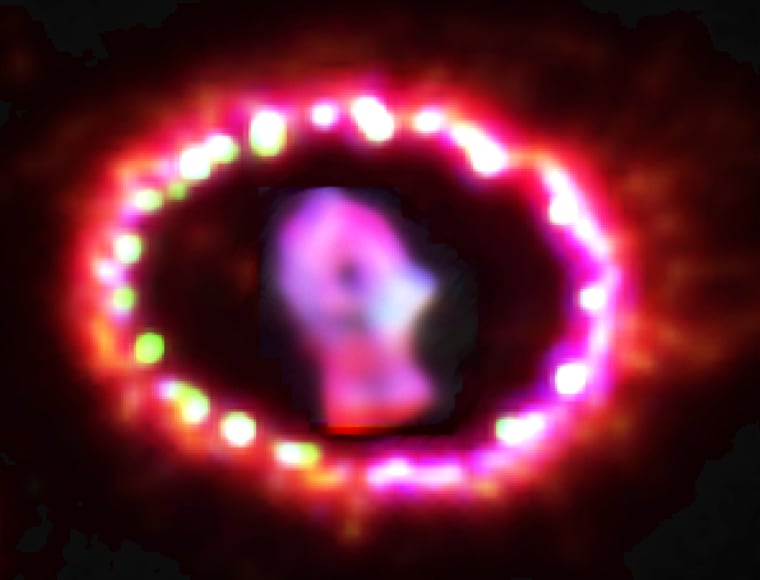The glowing entrails of an exploding star, thought to have faded over time, now appear to be lighting up again, a new Hubble Space Telescope photo reveals.
NASA released the new Hubble image of the well-known star explosion, called Supernova 1987A, on Friday. The photo shows the closest supernova explosion witnessed in almost 400 years. This has allowed astronomers to study the outburst's evolution in unprecedented detail.
In the latest study of Supernova 1987A, a team of astronomers announced that the debris from the explosion that had faded over the years is brightening. This suggests that the star explosion, which is located 165,000 light-years away in the Large Magellanic Cloud (a close neighbor of our own Milky Way galaxy), is turning into a so-called supernova remnant. [See Hubble's new photo of Supernova 1987A]
The research is detailed in Thursday's edition of the journal Nature.
Supernovas typically transition into remnants when the exploded material starts to fade, but the brightness increases due to interactions between the debris cloud and surrounding gas. This cosmic shift is usually difficult for astronomers to study, but due to the relatively close proximity of the Large Magellanic Cloud, astronomers have been able to make detailed observations of Supernova 1987A periodically from 1994 to 2009.
"Supernova 1987A has become the youngest supernova remnant visible to us," said Robert Kirshner of the Harvard-Smithsonian Center for Astrophysics in Cambridge, Mass. "It's only possible to see this brightening because SN 1987A is so close and Hubble has such sharp vision."
Kirshner leads a long-term study of SN 1987A using the Hubble Space Telescope. Since its launch in 1990, Hubble has provided a continuous record of the changes in the supernova.
In the new Hubble image, SN 1987A is surrounded by a ring of material that blew off the star thousands of years before it exploded. The ring extends about one light-year (about 6 trillion miles or 9.5 trillion kilometers) across. Inside that ring, the star's guts are rushing outward in an expanding debris cloud.
Most of the light from the supernova comes from radioactive decay of elements that were created in the explosion. This light fades over time, but the brightening of SN 1987A's debris suggests that a new power source is lighting it.
The debris of 1987A is beginning to impact the surrounding ring, which is creating powerful shock waves that produce X-rays that can be observed by NASA's Chandra X-ray Observatory. Those X-rays are illuminating the supernova debris, and the heated shock waves are making it glow. This same process powers well-known supernova remnants in our own galaxy, such as Cassiopeia A.
Furthermore, since SN 1987A is still young, astronomers can study the remnants of the explosion to decode its history.
Eventually, that history will be lost when the bulk of the expanding stellar debris impacts the surrounding ring and shreds it, researchers said. But until then, SN 1987A offers astronomers the opportunity to watch as a supernova changes, they added.
Follow SPACE.com for the latest in space science and exploration news on Twitter @Spacedotcom and on Facebook.
